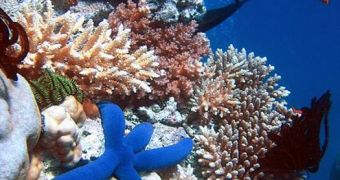Researchers at the University of Exeter, in the United Kingdom, have discovered in a new study that coral reefs grow faster in environments that are laden with marine sediments. This connection has not been suspected before, and could potentially provide a new means to boost conservation efforts.
An interesting aspect of the new study is that previous investigations had suggested a negative correlation between coral growth patterns and the presence of sediments in their environment, EurekAlert reports.
The research was conducted on a section of the Great Barrier Reef, in Australia. Called the Middle Reef, this section apparently displayed an accelerated growth rate, far larger than that of other sectors that were subjected to less stress from sediment deposits.
Scientists with the international research group published additional details of the analysis in the August 1 issue of the esteemed scientific journal Geology. The paper indicates that the Middle Reef lies just 4 kilometers (2.5 miles) off the mainland coast near Townsville, Australia.
Usually, coral reefs develop in clear water, where light can easily penetrate to moderate depths. Unlike these locations, the Middle Reef lies in so-called muddy waters. The sediments at the bottom of the sea are agitated by swirls, and their concentrations boosted by seasonal inflows from rivers.
One of the first things the research group did when the investigation began was to collect samples from a variety of locations in the Middle Reef. Scientists then conducted radiocarbon dating analysis on the samples, in order to figure out the reef's historic growth patterns.
The data revealed that this coral reef began growing just 700 years ago, which means that it is relatively young. Interestingly, over the years, the rate at which the reef grows has accelerated, reaching a level as high as 1 centimeter per year.
Scientists also found that periods where land-derived sediment concentrations were at their peak coincided with the fastest growth rate, of up to 1.3 centimeters annually. These values are significantly higher than those recorded in clearer areas of the Great Barrier Reef.
“Our research challenges the long-held assumption that high sedimentation rates are necessarily bad news in terms of coral reef growth. It is exciting to discover that Middle Reef has in fact thrived in these unpromising conditions,” UE professor of geography, Chris Perrcy, explains.
“It is, however, important to remain cautious when considering what this means for other reefs. Middle Reef includes corals adapted to deal with high sedimentation and low light conditions. Other reefs where corals and various other reef organisms are less well adapted may not do so well if sediment inputs increased,” he concludes.

 14 DAY TRIAL //
14 DAY TRIAL //